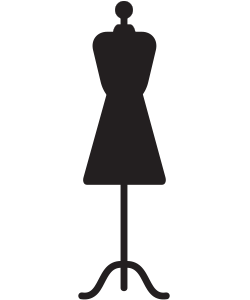After my custom-made duvet cover and pillow shams, I decided to tackle a smaller project that I had been waiting to try for a while. I was given a practically new, straight-cut shift dress by a good friend. It was a couple of sizes too big and needed some significant alterations to work for me. I decided that I would take in the dress and also add shaping to give it a more classic fit.
Here is what the dress looked like before:
As you can see, it needs some work, including removing those very oddly placed front pockets!
Here are the tools and equipment I used:
- Stitch ripper
- Measuring tape
- Lots of pins
- Dressmakers chalk
- Scissors
- Sewing machine (unless you’re really good with needle & thread)
- Black thread
Time to get started. Step one is to take down the hem.
As you can see in the ‘before’ picture above, the lining of the dress was sewn in to the yolk so I had to open up a hole in both under arms. I recommend first estimating how much you are going to take in the bust of the dress so you don’t undo the lining any more than you have to.
Next up for removal were those oddly placed pockets. You can see why the stitch ripper is the first tool that I listed at the beginning. It’s a requirement for every alteration project!
Pocket gone!
Once all of the hems/seams were removed, my next step was to work on the shape of the dress. I began by making two darts on the front of the dress. I figured out how long to make the darts by measuring the length of my torso from bust to hips. I marked this dart length on the two front seams of the dress and also marked where my waist (or narrowest part) was on this measurement.
I folded the dress along each of the existing front seams and pinned right sides together. I started by pinning 2.5 cm away from the original seam at my waist mark. This spot marked the widest part of the dart, and the narrowest part of the finished dress. From that point I tapered my pins outward toward the top and bottom of the dart, making a smooth transition from the dart back to the original seam.
If the new darts are long enough, they should have the added bonus of closing those pesky pocket openings perfectly. If not, continue pinning along the old seam line until you have closed off the pocket openings and sew them as an extension of your darts.
Once both front darts are in, you can start taking in the sides. I used my measurements and also traced another fitted dress so that I could get the right taper to make the skirt more A-line.

I pined and marked the new shape and sewed both sides all the way from the arm hole facing to the bottom of the skirt.
At this point TRY ON the dress to make sure that it fits before finishing the seams. I had to make a couple of minor alterations before the fit was perfect. Once I was sure that I had the dress fitting the way I wanted, I went ahead and took in the lining as well. I didn’t spend a lot of time measuring and shaping the lining but I did try to make sure that it would match up at the arm holes. I also wasn’t that careful with my stitching (I used a zig zag rather than a straight stitch plus an overlock) but I did try it on one more time to make sure it fit before cutting off the excess fabric.
When I was finished the side seams, I found that there was some puckering in the lower back. I decided to add two more darts on either side of the centre back panel to allow the dress to go in at my lower back. I did this the same way as I had done the front darts but made them much shorter and centred at my lower back rather than running the entire length of my torso. This was mostly because the zipper for the dress runs along one of the back seams and left little room for a longer dart. The darts pulled the dress in and reduced most of the bunching.
Here are the back darts:
… and the front darts.
All that was left was reattaching the lining at the armholes…
… not perfect but pretty close. And to redo the hem.
Here is a before and after photo.
You can see that the dress has much more shape after the addition of the darts and re-shaping of the side seams. It also fits far better.
I am pretty thrilled with how this alteration turned out. I’ve already worn the dress to work with a white collared shirt and black tights. In the spring I will try it with a silk blouse or a cardigan and flats.
That’s it for this alteration project. Good luck with your next project and thanks for stopping by!
~ Lindsay

















